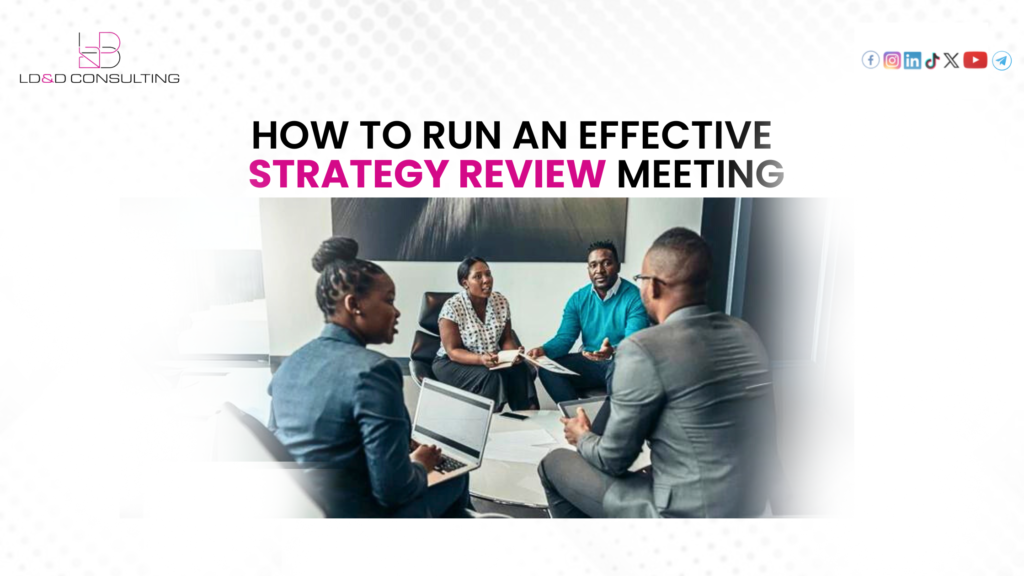
The strategy review meeting is often feared, sometimes neglected but is very essential for keeping your business on course. When done right, these meetings are like pit stops for your team, like a chance to refuel, check the map and make sure everyone’s still heading in the same direction. Let’s find out how to turn your strategy review meetings into engaging, impactful sessions that inspire action and drive results.
1. Set Clear Objectives Before the Meeting
Just catching up won’t cut it. Start with a clear, exciting purpose. Why are we here? “Reviewing strategy” sounds vague, so spice it up. Are you recalibrating to tackle new challenges? Evaluating what’s working and what’s not? Are you reviewing key performance indicators? Adjusting project timelines? Identifying new growth opportunities? A well-planned meeting starts with a clear objective so give the team something specific to rally around and they’ll come to the meeting ready to contribute. Communicate these objectives ahead of time to help your team prepare, ensuring that the discussion remains focused.
2. Gather Data and Insights in Advance
Data is gold, yes, we know but too much data can turn a lively room into a nap session. It is necessary to collect essential metrics and insights before the meeting while focusing on highlights. With the basics covered, the team can spend more time discussing ideas and less time crunching numbers. Gather relevant reports and insights from the team beforehand, whether they be metrics, progress reports, or customer feedback. The most effective strategy review meetings are grounded in data, so, equip your team with updated information to assess progress effectively.
3. Focus on Alignment, Not Blame
Strategy review meetings should feel more like pep talks and less like courtrooms. They should be about improving, not pointing fingers. The aim is to foster a growth mindset where the team can openly discuss setbacks without fear of blame. Instead of dissecting what went wrong, ask, “What can we try next?” or “How can we pivot?” It keeps the energy up and shows your team that challenges are just stepping stones. Foster a positive, solutions-oriented environment where everyone feels safe discussing challenges openly. If a project or initiative didn’t go as planned, discuss ways to pivot and improve without making team members defensive.
4. Encourage Open Discussion and Diverse Perspectives
It’s easy to get stuck in a rut with the same-old structure. Spice things up! Dedicate the first 15 minutes to “wins and wows” where each member shares a quick win. Then, move into challenges, followed by brainstorming. Mixing up the structure keeps people on their toes and gives everyone something to look forward to. The best insights often come from diverse perspectives, therefore, encourage everyone to share their opinions, ask questions, and suggest adjustments. Create space for quieter team members to contribute as well, sometimes the best ideas come from the least vocal participants.
5. Identify Key Takeaways and Action Items
A good meeting ends with clear, actionable steps because if it’s fuzzy, it’s useless. Assign specific owners and timelines to each action item, and follow up on these at the next meeting. Your team leaves knowing exactly what to do next and when they come back, they’re ready to talk about results. At the end of each review meeting, summarize key takeaways and clearly outline the next steps. What adjustments need to be made? Who will handle them and by when? Assign specific action items and timelines to keep everyone accountable.
6. Use Technology to Keep Meetings Efficient
Incorporating project management software, data dashboards, and video conferencing platforms can keep your meeting organized and engaging. Project management apps like Trello or Asana are fantastic for tracking actions. Visual tools like Miro let teams brainstorm and collaborate on the fly, making meetings interactive even when virtual. Video conferencing tools, particularly for remote teams allow for face-to-face discussions, adding a personal touch that builds team camaraderie and engagement.
7. End on a Positive Note
A little celebration goes a long way! Wrap up by recognizing accomplishments, sharing team wins, or just giving a round of applause for hitting milestones. Leave the meeting with everyone feeling pumped up and ready to tackle the next round of goals. Don’t let your meeting end on a heavy note of to-do lists. Thank your team for their hard work and contributions, reinforcing a positive team culture and motivation to keep moving forward.
In Conclusion: Strategy Reviews as a Tool for Growth
Regular strategy review meetings aren’t just about staying on track, they’re opportunities for learning, growth and team alignment. By running effective, engaging strategy review meetings, you can foster a culture of continuous improvement, where every team member feels empowered to contribute to the organization’s success. With the right mix of preparation, data-driven insights, open discussion, and positive reinforcement, your strategy review meetings can become a catalyst for powerful business growth.
Meanwhile, do not forget to CONTACT US for your HR Outsourcing, Staffing and Recruitment Needs.


seo çalışması
July 13, 2025Pretty! This has been a really wonderful post. Many thanks for providing these details.